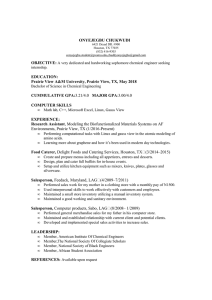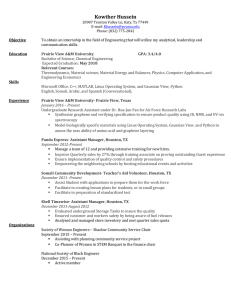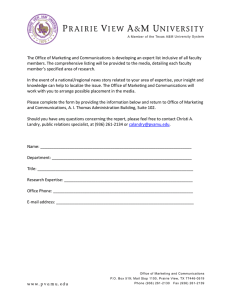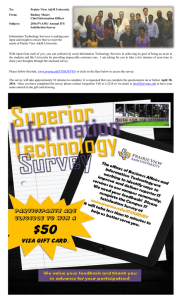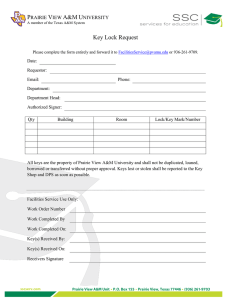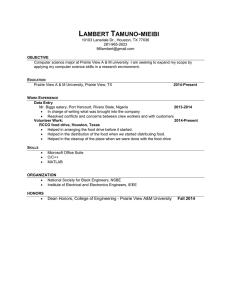I n t e r n a Ɵ o n... Center for InternaƟonal Business EducaƟon
advertisement
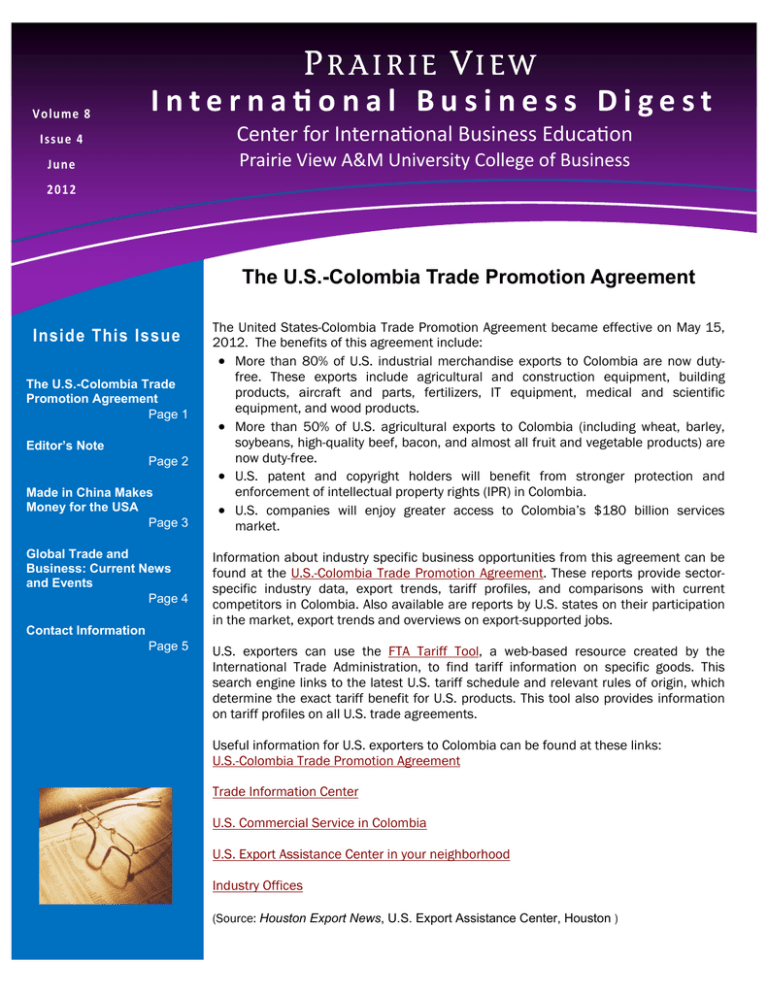
Volume 8 InternaƟonal Business Digest Issue 4 Center for InternaƟonal Business EducaƟon June Prairie View A&M University College of Business Volume 1, Issue 1 Newsletter Date 2012 The U.S.-Colombia Trade Promotion Agreement Inside This Issue The U.S.-Colombia Trade Promotion Agreement Page 1 Editor’s Note Page 2 Made in China Makes Money for the USA Page 3 Global Trade and Business: Current News and Events Page 4 Contact Information Page 5 The United States-Colombia Trade Promotion Agreement became effective on May 15, 2012. The benefits of this agreement include: More than 80% of U.S. industrial merchandise exports to Colombia are now dutyfree. These exports include agricultural and construction equipment, building products, aircraft and parts, fertilizers, IT equipment, medical and scientific equipment, and wood products. More than 50% of U.S. agricultural exports to Colombia (including wheat, barley, soybeans, high-quality beef, bacon, and almost all fruit and vegetable products) are now duty-free. U.S. patent and copyright holders will benefit from stronger protection and enforcement of intellectual property rights (IPR) in Colombia. U.S. companies will enjoy greater access to Colombia’s $180 billion services market. Information about industry specific business opportunities from this agreement can be found at the U.S.-Colombia Trade Promotion Agreement. These reports provide sectorspecific industry data, export trends, tariff profiles, and comparisons with current competitors in Colombia. Also available are reports by U.S. states on their participation in the market, export trends and overviews on export-supported jobs. U.S. exporters can use the FTA Tariff Tool, a web-based resource created by the International Trade Administration, to find tariff information on specific goods. This search engine links to the latest U.S. tariff schedule and relevant rules of origin, which determine the exact tariff benefit for U.S. products. This tool also provides information on tariff profiles on all U.S. trade agreements. Useful information for U.S. exporters to Colombia can be found at these links: U.S.-Colombia Trade Promotion Agreement Trade Information Center U.S. Commercial Service in Colombia U.S. Export Assistance Center in your neighborhood Industry Offices (Source: Houston Export News, U.S. Export Assistance Center, Houston ) Editor’s Note Greetings. It gives us great pleasure to bring to you the 32nd issue of the Prairie View International Business Digest, an electronic quarterly newsletter produced by the Center for International Business Education at Prairie View A&M University. This issue features three sections. The first section is a short article on the U.S.Colombia Trade Promotion Agreement that became effective on May 15th. The second section presents interesting facts and figures about low Chinese import content in U.S. products. The final section highlights current global business news and events. Please note that all URL links are active and you can go directly to an article from the table of contents section on the first page. Dr. Rahim Quazi Editor We hope you continue to find this e-newsletter a valuable channel for important information relating to international business. We do hope our efforts will inspire greater number of local firms to seek out new global business opportunities. Should you have any questions or suggestions, please feel free to contact us. Thank you for your support. Rahim Quazi, Ph.D. Editor, Prairie View International Business Digest Prairie View A&M University - College of Business E-mail: rmquazi@pvamu.edu Phone: (936) 261-9225 Prairie View InternaƟonal Business Digest Page 2 Volume 8 Issue 4 “Made in China” Makes Money for the USA According to a recent report from the Federal Reserve Bank of San Francisco (FRBSF), about 55% of the amount American consumers spend on products made in China actually stays in the US - going to American companies, workers, marketers, retailers, and transport providers. Also imports from China amount to a very tiny portion of our total economy: about 2.5% of our Gross Domestic Product (GDP), whereas total imports from around the world accounted for about 16% of our GDP last year. With the exceptions of furniture and household items, electronic goods, and clothing and shoes, the vast majority of goods and services sold in the American market is actually produced domestically. About one-third of clothing and shoe items and onefifth of furniture items purchased by American consumers carry “Made in China” labels. According to the FRBSF report, it is services (not manufactured products) that make up the overwhelming majority of the U.S. economy, and no services are imported from China. About 88.5% of U.S. consumer spending is for products and services originating locally, and services make up about two-thirds of that spending. A large number of component parts – like semiconductor chips and designs used in the iPhone – actually originate in the U.S. According to a 2009 Asian Development Bank Institute study, it cost about $179 to produce an iPhone in China, which is then sold in the U.S. for about $500. Out of the $179 U.S. retail cost that consisted of Chinese imported content, only $6.50 was spent for assembly costs in China and the rest ($172.50) was spent on parts from other countries, including $10.75 for U.S. parts. The FRBSF report also discusses China’s growing inflation. The recent inflation data show an upward trend for the last three years, which is causing some concerns among economists. However, given the low levels of Chinese content in U.S. products, the report concludes that Chinese inflation will likely have very little direct impact on U.S. prices. Source: http://finance.fortune.cnn.com/2011/08/12/made-in-china-makes-money-for-the-u-s-a/?iid=HP_LN (Sheridan Prasso, Contributor) Prairie View InternaƟonal Business Digest Page 3 Volume 8 Issue 4 Global Trade & Business: Current News and Events Utilizing Census Data Two Allen Center, Houston, June 19 The U.S. Census Bureau and Greater Houston Partnership will hold a workshop on the Census Bureau surveys and products and how to use them in developing business strategies. Attendees will learn how to access data, use Census Bureau tools, and about publically available free resources. For more information, contact Ms. Deanna Morrow at dmorrow@houston.org. Maquiladora Sales Mission and B2B Event Ciudad Juarez and El Paso, June 20-21 This is a good opportunity to learn about the maquiladora industry and promote U.S. companies to Mexican assembly plants. The participation cost is $425. For more information, contact Mr. Robert Queen (Director, U.S. Export Assistance Center, El Paso) at 915-929-6971 or robert.queen@trade.gov. Business Mission to Mexico Mexico City, June 24 The U.S.-Mexico Chamber of Commerce will lead a business mission to create linkages for Houston businesses with potential clients and businesses based in Mexico. The Chamber will organize lectures on Mexico’s economic and market trends and also arrange one-on-one customized meetings for clients. For more information, contact Mr. Pete Garcia at pete@chambergc.org. PECOM 2012 Tabasco, Mexico, July 12-14 The Petroleum Exhibition & Conference of Mexico (PECOM) is the largest gas and oilfield trade event in Mexico. For more information, contact: SBasler@ieimail.com. Renewable Energy Gold Key Mission Manila, Philippines and Bangkok, Thailand, August 11-17 This is a two-stop Gold Key Mission to learn about the untapped business opportunities in Thailand and the Philippines – both offer promising markets for the sale of U.S. energy products and services. Participants will have two sets of partner meetings in each stop, briefings by government officials, and learn about the funding and financing available from the U.S. Department of Commerce and other government agencies. For registration information, check: http://export.gov/newyork/newyorkcityexportassistancecenter/te/le/retm/index.asp Smart Grid Trade Mission London, UK, October 15-17 This mission will offer a cost-effective means for U.S. firms to enter the promising UK market for smart grid equipment, technology and services. UK public and private organizations are investing tens of billions of dollars to upgrade the grid, creating significant business opportunities for companies that have developed relevant products, services or technologies. For more information, check: http://export.gov/unitedkingdom/events/featuredevents/eg_gb_045700.asp Sources: Houston Export News, U.S. Export Assistance Center, Houston International Newsletter, City of Houston Prairie View InternaƟonal Business Digest Page 4 Volume 8 Issue 4 PVAMU College of Business Vision and Mission Statements Vision Statement: Our vision is to empower students from diverse backgrounds to become productive and ethical business professionals who are among the best in the world. Mission Statement: We provide a diverse student body with an education that creates highly productive professionals who are ethical, entrepreneurial, and prepared to succeed in the global economy. The College achieves this through excellence in teaching, research and service, and engagement with the business community and other stakeholders. The student experience is distinguished by personal attention, teamwork, leadership training, and appreciation of the social responsibility of business. Prairie View A&M University College of Business P.O. Box 519; MS 2300 Prairie View, TX 77446 Next Issue - September 2012 If you would like to receive an electronic version of this newsletter, please contact Dr. Rahim Quazi in the College of Business at 936-261-9225 or rmquazi@pvamu.edu Visit our website! www.pvamu.edu/business or www.pvamu.edu/pages/4478.asp
